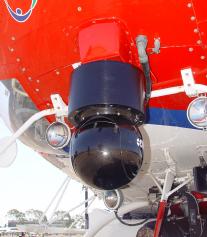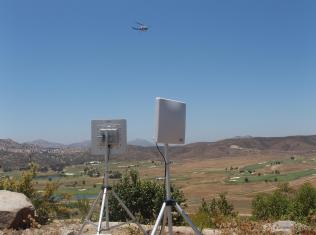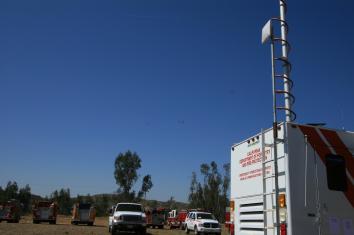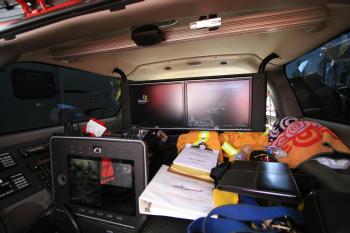
|
|
May 31, 2007 The 3Cs project and HPWREN demonstrated a multi-point video conference with a SDFD firefighter helicopter real-time video downlink during the 2007 Interagency Wildland Fire Drill
On May 29, 2007, the Regional Command and Control Communications (3Cs) project conducted a series of tests to connect with and pass traffic across the HPWREN network, in conjunction with the local Wildland Fire Drill hosted by the Barona Fire Department. 3Cs is a multi-agency effort to expand and improve interagency communication and collaboration during large scale incidents. The current 3Cs network became operational in March 2007, with additional legs currently in construction to expand coverage areas in San Diego and Imperial Counties. Acting as a public safety intranet, the 3Cs network provides a secure channel for the sharing of data and video between law enforcement and fire-rescue agencies. For the purposes of the drill, the goal was to test using the HPWREN network as a transport network to connect to the 3Cs network from an ICP. Specifically, the tests were organized as follows:
HPWREN provided network connectivity to a CalFire Command Van located at the drill's Incident Command Post (ICP) using a microwave link from the HPWREN backbone via a nearly hilltop-relay. The HPWREN and 3Cs networks were then directly connected at a common location in San Diego to both networks. Static routes on both networks were created specifically for the drill. IP traffic was confirmed between the networks within the first hour of configuration and testing.
Once network connectivity was established, video calls were made to two separate 3Cs video conference bridges to judge video quality and latency. 3Cs commonly uses video applications as a means to test network quality and loading. Because video conferencing and video streaming both use a great deal of bandwidth and require extremely low latency and packet loss to ensure a good quality picture, these applications have been very valuable in testing the 3Cs network. Operationally, video conferencing provides an alternative to radios for communication between and among agencies on the network. For ICPs, video conferencing facilitates planning and resource management between command staff at the incident and support staff at the agencies. Video streaming is used for incident situational awareness, by distributing video feeds with regional helicopters at the incidents. The 3Cs project is in the process of implementing regional receivers for video digitally downlinked from the helicopters. The goal is to have consistent coverage for video downlink throughout the San Diego metropolitan area. For ICPs outside the downlink coverage area, 3Cs uses local receivers mounted in vehicles or portable suitcases to receive and store video. During the drill, video feeds downlinked to a vehicle mounted receiver at the ICP were then encoded and broadcast across the 3Cs network using the 3Cs video conferencing bridges. Video quality was evaluated to determine if video transmitted from the field had sufficient quality to provide enough information to operations center staff to utilize in supporting the incident. We were able to successfully complete all three tests and are very happy with the results. These tests not only represent a cooperative effort between 3Cs and HPWREN to support the regions first responders, but will also set the stage for work planned in future phases of the 3Cs project to provide additional coverage to sites in the field.
Many thanks to Tom Gardner and Doug Mitchell from CalFire, Dale Fortney, Sara Diaz and Aristo Von Hoffman from Enforcement Support Agency, Len Angle and Brian Tripp from San Diego County Sheriffs Wireless Services Division, Brian Fennessey, Greg Donnelly, Eric Allen, and the members for the SDFD Air Operations Division (Copter1) from San Diego Fire Rescue Department, Gary Croucher from San Miguel Fire, as well as Hans-Werner Braun and the entire HPWREN team that supported the Wildland Fire Drill. Sara Diaz
Various photos from this year's Interagency Wildland Fire Drill can be found at /Photos/20070529/, /Photos/20070529.rserabia/, and /Photos/20070530/ A previous writeup about 3Cs collaborations is at /news/20061130/. |






